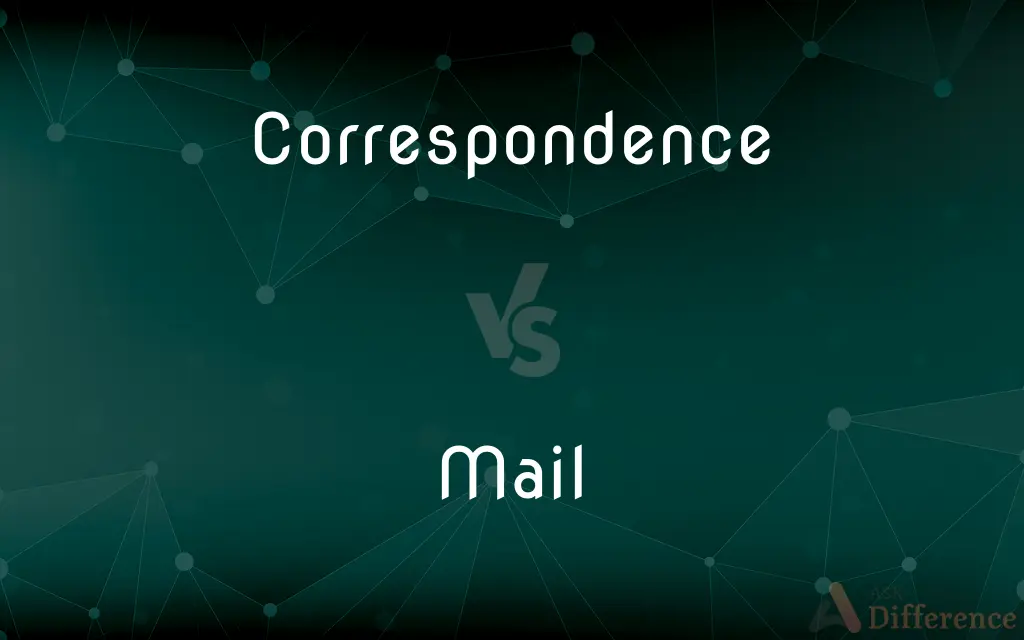Correspondence vs. Mail — What's the Difference?
Edited by Tayyaba Rehman — By Fiza Rafique — Updated on March 27, 2024
Correspondence refers to the exchange of letters and communication, focusing on the content and purpose, while mail encompasses the physical system of transporting documents and parcels.

Difference Between Correspondence and Mail
Table of Contents
ADVERTISEMENT
Key Differences
Correspondence involves the exchange of letters or messages between parties, often emphasizing the content and purpose of the communication. It is usually associated with formal, professional, or personal written communications. Whereas mail refers to the system used for sending and receiving documents, letters, and parcels. This includes both the physical and electronic means of transport, making it a broader concept than correspondence.
Correspondence is typically used to denote a series of communications between two parties, reflecting a continuous exchange of information or ideas. This can include emails, letters, and memos that contribute to a dialogue. On the other hand, mail can be a one-time shipment of documents or goods, not necessarily implying an ongoing conversation or exchange of ideas.
In the context of business or professional settings, correspondence often holds a formal tone and structure, aimed at maintaining records, making inquiries, or providing information. Mail, however, can range from formal business documents to informal packages, encompassing a wider variety of content without the specific intention of dialogue.
Correspondence is primarily concerned with the content and significance of the messages being exchanged. It focuses on the textual or communicated substance between individuals or entities. Whereas mail is concerned with the logistics of sending and receiving physical or electronic items, placing more emphasis on the medium than the message itself.
While correspondence has evolved to include email and other digital forms of communication, it still retains the essence of personal or direct communication between parties. Mail has similarly expanded to include electronic mailing systems but is more inclusive of various types of dispatches, including marketing materials, catalogs, and unsolicited information.
ADVERTISEMENT
Comparison Chart
Definition
Exchange of letters or messages with a focus on content and purpose.
System for sending and receiving documents, letters, and parcels.
Purpose
To convey specific information or maintain a dialogue.
To transport items from one place to another.
Formality
Often formal and structured, especially in business contexts.
Can range from formal to informal, depending on the content.
Medium
Includes letters, emails, and memos.
Encompasses physical and electronic means, including packages.
Implied Interaction
Suggests an ongoing exchange or dialogue.
Does not necessarily imply a dialogue or continuous exchange.
Compare with Definitions
Correspondence
Messages exchanged through digital platforms.
The team used a messaging app for quick correspondence.
The process of dispatching documents and goods.
Mail your application to the university before the deadline.
Correspondence
The act of writing or communicating in letters.
His correspondence with the author was later published.
Electronic mail used for communication.
She checks her mail first thing in the morning.
Correspondence
Email communication for professional or personal purposes.
She handled all correspondence via her work email.
Physical items sent or received through the postal system.
The package arrived in the mail today.
Correspondence
A series of communications maintaining a dialogue.
Their correspondence provided valuable insights into the project.
A collection of messages in one's email inbox.
He organized his mail into folders for better efficiency.
Correspondence
A formal exchange of letters between two parties.
The business correspondence between the two companies spanned several months.
The system of sending letters and packages through postal services.
He sent the contract via certified mail.
Correspondence
The act, fact, or state of agreeing or conforming
The correspondence of the witness's statement with the known facts suggests that he is telling the truth.
The mail or post is a system for physically transporting postcards, letters, and parcels. A postal service can be private or public, though many governments place restrictions on private systems.
Correspondence
Communication by the exchange of letters, emails, or other forms of written messages.
Letters and parcels sent by post
I did not receive any mail
Correspondence
The messages sent or received.
Armour made of metal rings or plates joined together flexibly
A coat of mail
He had a mail shirt
Correspondence
Mutual communication or discourse:
Send (a letter or parcel) by post
Three editions were mailed to our members
Correspondence
Friendly discussion.
Clothe or cover with mail
A mailed gauntlet
Correspondence
(uncountable) Reciprocal exchange of civilities, especially conversation between persons by means of letters.
Materials, such as letters and packages, handled in a postal system
The volume of mail increases around the holidays.
Correspondence
(uncountable) Newspaper or news stories.
Postal material for a specific person or organization
Could you pick up my mail at the office?.
Correspondence
Postal or other written communications.
Material processed for distribution from a post office at a specified time
Delivered the morning mail around town.
Correspondence
Congruity or similarity between different things, people, etc:
A postal system. Used with the, sometimes in the plural
Used the mail to send the supplies.
Advertisements sent through the mails.
Correspondence
(countable) An agreement of situations or objects with an expected outcome.
Chiefly British A vehicle by which mail is transported.
Correspondence
A relation.
Mail or messages sent electronically; email.
Correspondence
A similarity between physical and spiritual things e.g. light to wisdom, or warmth to love
Flexible armor composed of small overlapping metal rings, loops of chain, or scales.
Correspondence
Friendly intercourse; reciprocal exchange of civilities; especially, intercourse between persons by means of letters.
Holding also good correspondence with the other great men in the state.
To facilitate correspondence between one part of London and another, was not originally one of the objects of the post office.
The protective covering of certain animals, as the shell of a turtle.
Correspondence
The letters which pass between correspondents.
Rent, payment, or tribute.
Correspondence
Mutual adaptation, relation, or agreement, of one thing to another; agreement; congruity; fitness; relation.
To send by a postal system
Mailed the letter yesterday.
Correspondence
Communication by the exchange of letters
To send letters and other material by a postal system.
Correspondence
Compatibility of observations;
There was no agreement between theory and measurement
The results of two tests were in correspondence
To cover or armor with mail.
Correspondence
The relation of correspondence in degree or size or amount
A bag or wallet.
Correspondence
A function such that for every element of one set there is a unique element of another set
A bag containing letters to be delivered by post.
Correspondence
Communication by exchange of letters
The material conveyed by the postal service.
Don't forget to pick up the mail on your way.
Correspondence
(mathematics) an attribute of a shape or relation; exact correspondence of form on opposite sides of a dividing line or plane
(dated) A stagecoach, train or ship that delivers such post.
Correspondence
Similarity by virtue of correspondence
The postal service or system in general.
He decided to send his declaration by mail.
The letters, parcels, etc. delivered to a particular address or person.
(uncountable) Electronic mail, e-mail: a computer network–based service for sending, storing, and forwarding electronic messages.
A trunk, box, or bag, in which clothing, etc., may be carried.
(uncountable) Armour consisting of metal rings or plates linked together.
(nautical) A contrivance of interlinked rings, for rubbing off the loose hemp on lines and white cordage.
Any hard protective covering of an animal, as the scales and plates of reptiles, shell of a lobster, etc.
A spot on a bird's feather; by extension, a spotted feather.
(historical) An old French coin worth half a denier.
A monetary payment or tribute.
Rent.
Tax.
(ditransitive) To send (a letter, parcel, etc.) through the mail.
(ditransitive) To send by electronic mail.
Please mail me the spreadsheet by the end of the day.
(transitive) To contact (a person) by electronic mail.
I need to mail my tutor about the deadline.
(transitive) To arm with mail.
(transitive) To pinion.
A spot.
A small piece of money; especially, an English silver half-penny of the time of Henry V.
Rent; tribute.
A flexible fabric made of metal rings interlinked. It was used especially for defensive armor.
Hence generally, armor, or any defensive covering.
A contrivance of interlinked rings, for rubbing off the loose hemp on lines and white cordage.
Any hard protective covering of an animal, as the scales and plates of reptiles, shell of a lobster, etc.
We . . . strip the lobster of his scarlet mail.
A bag; a wallet.
The bag or bags with the letters, papers, or other matter contained therein, conveyed under public authority from one post office to another; the whole system of appliances used by government in the conveyance and delivery of mail matter.
There is a mail come in to-day, with letters dated Hague.
That which comes in the mail; letters, etc., received through the post office.
A trunk, box, or bag, in which clothing, etc., may be carried.
To arm with mail.
To pinion.
To deliver into the custody of the postoffice officials, or place in a government letter box, for transmission by mail; to post; as, to mail a letter.
The bags of letters and packages that are transported by the postal service
The system whereby messages are transmitted via the post office;
The mail handles billions of items every day
He works for the United States mail service
In England they call mail `the post'
A conveyance that transports mail
Any particular collection of letters or packages that is delivered;
Your mail is on the table
Is there any post for me?
She was opening her post
(Middle Ages) flexible armor made of interlinked metal rings
Send via the postal service;
I'll mail you the check tomorrow
Cause to be directed or transmitted to another place;
Send me your latest results
I'll mail you the paper when it's written
Common Curiosities
What is the main difference between correspondence and mail?
Correspondence focuses on the exchange of messages with specific content and purpose, while mail is the system for sending and receiving documents and parcels.
Can emails be considered correspondence?
Yes, emails can be considered a form of correspondence, especially when they involve ongoing communication or exchange of information.
Can social media messages be considered correspondence?
Yes, social media messages can be considered a form of correspondence, especially when they involve direct, personal communication between users.
What types of items can be sent through the mail?
The mail can include documents, letters, packages, and parcels, ranging from personal letters to commercial goods.
Is all mail considered correspondence?
Not all mail is considered correspondence, as mail can include items that do not involve an exchange of information, such as packages.
Does correspondence always require a response?
While correspondence often implies an exchange or dialogue, not every instance requires a response, depending on the context and purpose.
How does correspondence work in a business setting?
In a business setting, correspondence typically involves formal communications, such as letters and emails, aimed at exchanging information or maintaining records.
How has electronic mail changed the concept of correspondence?
Electronic mail has made correspondence faster and more efficient, allowing for instant communication and easier storage and retrieval of messages.
What role does the postal service play in the mail system?
The postal service is crucial for the physical transportation and delivery of mail, including letters, documents, and packages.
Is it possible to track correspondence like mail?
Yes, digital correspondence can be tracked through read receipts and email tracking tools, while physical mail can often be tracked through postal services.
How do privacy concerns differ between correspondence and mail?
Privacy concerns may be more pronounced in correspondence, given the personal or sensitive nature of the information exchanged, while mail can also raise privacy issues, especially with personal data handling.
Do businesses still use traditional correspondence?
Yes, many businesses still use traditional correspondence for formal communications, contracts, and legal documents, despite the prevalence of digital methods.
What is the environmental impact of correspondence and mail?
The environmental impact varies; digital correspondence has a lower physical footprint, whereas traditional mail involves paper usage and transportation resources.
Can correspondence be considered legal documents?
Yes, certain types of correspondence, such as contracts or formal agreements communicated via letters or emails, can be considered legal documents.
How are disputes handled in correspondence and mail?
Disputes in correspondence may involve clarifications or legal actions based on the content of the communications, while disputes in mail could involve issues with delivery or condition of the items.
Share Your Discovery

Previous Comparison
Coupe vs. Limousine
Next Comparison
Reject vs. DismissAuthor Spotlight
Written by
Fiza RafiqueFiza Rafique is a skilled content writer at AskDifference.com, where she meticulously refines and enhances written pieces. Drawing from her vast editorial expertise, Fiza ensures clarity, accuracy, and precision in every article. Passionate about language, she continually seeks to elevate the quality of content for readers worldwide.
Edited by
Tayyaba RehmanTayyaba Rehman is a distinguished writer, currently serving as a primary contributor to askdifference.com. As a researcher in semantics and etymology, Tayyaba's passion for the complexity of languages and their distinctions has found a perfect home on the platform. Tayyaba delves into the intricacies of language, distinguishing between commonly confused words and phrases, thereby providing clarity for readers worldwide.















































